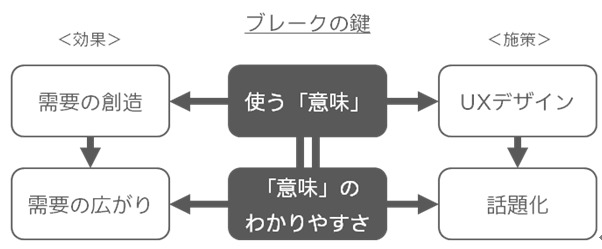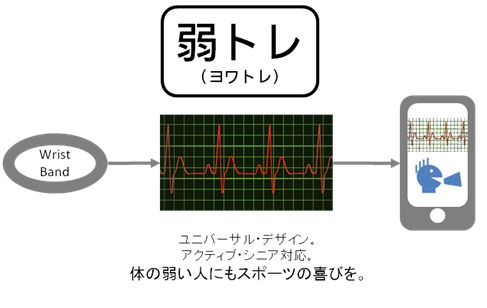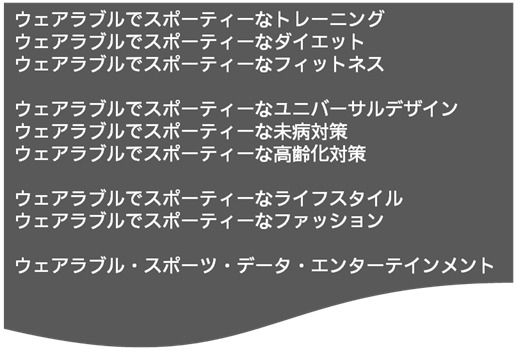Note: This website was automatically translated, so some terms or nuances may not be completely accurate.
Sports × Wearables: "Wearables Change Lives... What's the Key to Breaking Through?!" (Part 2)
The SPOLUTION team, a solution unit that attempts to create new business opportunities by viewing sports content not just as media slots but also as solutions. Team members will introduce future sports-related business opportunities from their respective perspectives in a relay column format.

I'm Noguchi from the SPOLUTION team. Continuing from last time, I'll discuss [Sports × Wearables].
<This Session's Content>
(4) Just as an example, though
(5) The Potential of [Sports × Wearables]
(4) Just as an example, though

For users, there is no demand unless the product/service has a "meaning" in their daily lives.
Demand won't expand unless the "meaning" of using it is easy to understand.
Therefore, the key to breaking through is designing the UX to make that "meaning" clear and creating buzz.
I wrote about this in the previous chapter. Now, let me explain how to implement this "UX design & buzz generation" using a hypothetical example.
Various wearable devices that measure heart rate are available.

While exercising, it transmits via Bluetooth to your smartphone, letting you see in real time how much your heart rate is increasing.
Compared to measuring heart rate from your earlobe on a gym treadmill, it's become much smarter. Sensors and transmitters are now placed on wristbands or other locations like the chest or back that don't interfere with exercise, making them quite stylish.
Your heart rate flashes on your phone in real time—beep, beep, beep.
This alone is enough to make techies swoon.
But SO WHAT?
What's so great about having to check your heart rate?
Unless you define the "meaning of being able to measure your heart rate in real time and in detail in your daily life," the possibility of breaking through won't arise.
Only when that "meaning" becomes clear, easily understood, and a topic people readily discuss will the seeds of a breakthrough begin to appear.
What kind of "meaning" can we establish? How can we design the UX and make it a talking point? The "Sporolution" team brainstormed.
Several ideas emerged, but here we'll introduce just one as an example.
UX Idea Example: "Yowatre (Weak Training) ~ Bringing the Joy of Sports to Those with Weak Bodies"
This idea repositions the meaning of measuring heart rate, not just as "training management," but as "a way for people who previously had no connection to sports to incorporate the joy of sports into their lives."
While exercise may be dangerous for those with serious heart conditions, wouldn't it be possible to work up a sweat while avoiding risks if they could constantly monitor their heart's detailed condition?
Not only those with weak hearts, but generally, people with frail bodies or the elderly often avoid exercise altogether, thinking it might be dangerous. Yet, when they actually try it, working up a sweat can feel surprisingly good and even bring a sense of happiness.
In other words, I see the "meaning" of this machine as enabling physically frail individuals and the elderly to experience the joy of sports without risking hospitalization.
Viewed this way, the machine shifts from being a "device that changes how you train" to being a "device that changes your life."
<Proposed Interface Design for This Machine>
What kind of interface would best embody this "meaning"?
The concept that emerged is "Rehabilitation Trainer."
It might seem a bit plain, but the purpose of this machine isn't to "support people already accustomed to sports," but to "help people who've never had a connection to sports incorporate it into their lives."
Users will surely have various concerns.
Gentle yet professional advice is needed to address these various concerns—health-related worries, training anxieties, and more.
What's needed isn't an "enthusiastic cheerleader" or a "strict drill sergeant," but a "kind and professional rehabilitation trainer."
We want this machine to fulfill the role of a physical therapist: supporting rehabilitation while avoiding danger, applying a certain level of load, and encouraging the individual.
So, what design and interactions should its screen and switches have? That's the mindset we should use to design the interface.
<Proposed naming and context for generating buzz around this machine>
To generate buzz around this "meaning," we first launch this machine with a name signifying "a sports trainer for people with physical limitations."
Let's call it "Weak-Tren" for now.
Then, whenever topics like "universal design" or "an aging society" come up, we seize interview opportunities on various programs and media content, strategically arranging for it to be featured there.
Having athletes who embody universal design principles use the product activates this mechanism. For example, seeing Paralympians or world champions in senior sports using it can become highly engaging content.

User interface, naming, content dissemination... all of these are part of UX (user experience).
In other words, this idea centers on the "meaning" of "bringing the joy of sports to the lives of people with physical challenges" and is an idea to "design the UX to make it conversation-worthy."
While many other ideas are possible, do you now understand what "designing UX to generate buzz" entails? Let's summarize↓
<Approach to "Designing UX to generate buzz">
If there's no "meaning" in using it, there's no demand.
Demand won't expand unless the "meaning" of use is easy to grasp.
"Meaning" → UX
"Making it easy to understand" → Becoming a topic of conversation
What kind of "meaning" can be set,
What kind of design would a user interface need to have to convey that "meaning"?
What kind of words and context (context) make that "meaning" become a topic of conversation?
We at the "Sporolution" team help facilitate that kind of thinking.
(5) The Potential of [Sports × Wearables]
Sports × Wearables might just change your life.
Through wearable devices, the joy of sports enters previously unexplored areas of daily life.
The emphasis on "joy" is particularly wonderful.
Things that enter our lives with a "must do" or "should do" attitude rarely gain traction. But sports come in with a positive stance: "Doing it is fun/makes you happy/looks cool." That's precisely why the probability of it breaking through increases.
Markets like "training," "dieting," and "fitness" are merely entry points.
If we look toward "wellness" and "medical" directions, we see growing markets like "universal design," "preventive healthcare," and "aging society solutions."
'Wearable and sporty universal design'
‘Wearable and sporty preventative healthcare’
‘Wearable and Sporty Solutions for Aging’
A world of "fun/delightful/stylish" positivity unfolds.
As product categories, it will expand into "health equipment," "health foods," "supplements," "medicines," "medical services," and more.
Considering that "Wearable & Sports" as a "style" will spread as a new form of self-expression for many people, a large market targeting "fashionable people in general" becomes visible.
‘Wearable and sporty lifestyle’
‘Wearable and sporty fashion’
Product categories also expand significantly to include "Fashion," "Apparel," the "spaces" where they are used like "Housing," "Interior," and "Automobiles," related "Food" and "Beverages," the venues providing them like "Restaurants" and "Malls," and the various "Content" proposing them, and so on.
Opportunities exist not only in the "participatory sports" market but also in the "spectator sports" market.
Using wearable devices to "visualize the exceptional performance of top athletes" not only helps "improve their own performance" but also expands business opportunities in the world of "media," "events," and "entertainment content," such as "sports events" and "broadcast content."
For example, if we could see everything about a Japanese national soccer player—how far they run, at what speed, how breathless they are, how intense their physical contact with opponents is, and even the angle and spin they apply when shooting—it would significantly change the viewing experience. Predicting goals, conceded goals, or the flow of the game might also become possible based on such data.
‘Wearable Sports Data Entertainment’
People may sign up for that membership site to see it, or subscribe to that broadcast channel. A new type of community might emerge where people share and discuss this data on social media.
Even larger-scale possibilities could be considered.
By digitizing and reconstructing every player's record from a match, using holographic or projection mapping technology, it might even be possible to recreate a game played elsewhere in 3D right in the stadium.
"Relive Japan's World Cup match at the National Stadium!" "Experience that Serie A star's goal scene live in the stadium!"... Since it's data, zooming in or out, or viewing from above, is completely free. You could even reconstruct and see angles the cameras missed. New excitement, new enjoyment would be born there. Such events would likely have huge drawing power.
There's potential for various products from various clients. Different technologies will intertwine there, giving birth to all sorts of new things.
Among these, I believe products that create new "meaning" within users' lives and transform their daily routines will break through.
We, the "Sporolution" team, are focusing on the expansive potential of this [Sports × Wearable] space. We are preparing to help unlock the potential of products and services and broaden business possibilities through our approach of "UX Design + Creating Buzz."


★What is the "Sporolution" Team?
It is an internal unit within Dentsu Inc. that approaches sports content not merely as "media assets," but as "solutions" to address business challenges and project issues, and plans accordingly.
The team brings together diverse talents including strategic planners, promotion planners, copywriters, art directors, technologists, consultants, and producers, all with extensive experience in sports planning. Through our Solution Director system, we provide not just "ideas for expression," but also "ideas for solutions," all under one roof.
Was this article helpful?
Newsletter registration is here
We select and publish important news every day
For inquiries about this article
Back Numbers
Author

Noguchi Yoshikazu
Dentsu Inc.
Corporate Office
As a strategic planner/consultant, I have served as the lead for IT and foreign-affiliated clients. Since 2016, Producer of the "Sporolution" team, a unit that leverages sports as a solution. He views sports as one of the few major business opportunities in a low-growth, aging society and harbors the ambition to revitalize Japan and Japanese companies through sports. Planning Director at the Content Business Design Center. Corporate Office since 2023.